Focus September 2002
 |
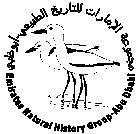 |
Focus September 2002
Index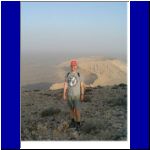
- Editorial
- Abu Dhabi Cruising in the Summer time
- Data on UAE fossils added to ADIAS website
- Wadi Qahfi Trip Friday 5th July 2002
- Ras Al Khaimah High Road (or "7 Emirates in 7 hours") Friday, 19th July 2002
- Jebel Rawdah (25th July, 2002)
- Twitch It! - Abu Dhabi birds for July and August
- Fujairah Bird Checklist released
- Lectures
- Excursions
- Committee members
- Corporate Sponsors of the ENHG 2002
- Survey of Information for the Marine & Coastal Area Stakeholders Of Abu Dhabi Emirate.
Editorial
For some, the time to go on leave from the Gulf is when you increasingly start to enjoy interesting conversations with Abu Dhabi taxi drivers, even though there is no shared common language. Who only knows what the taxi drivers might say to each other about their patrons later on? Anyway, just as the signs as to when to leave may be clear, so are those as to when it is time to come back again - and that, we all know, is when you start to look like the mugshot in your own passport.
So welcome back everyone to a new season of ENHG activities.
Starting off the autumn 2002 lecture programme on 3rd September will be Professor Drew Gardner. Drew is an avid herpetologist (night and day) and has spent more than a decade yomping about in the region. He is one of the foremost researchers in this field and his talk on 'The reptiles of the UAE and Oman', matched with superb slides of the animals themselves, as well as of their habitats and the local scenery, are an absolute treat - so please treat yourself and try to be there. Inveterate excursion leader, Charles Laubach, who always knows where he is even when he's lost, will present the second lecture of the month. Charles' presentation is on safety, particularly in the desert, and is an attempt by the committee to make sure that we don't lose any of our members, at least not before they've paid their subscription for next year. The lecture is accompanied by an ADCO desert driving safety video, access to which is something the group is extremely grateful to have.
You will start to notice changes to Focus, the group's newsletter, over the coming issues. We will, for example, be introducing a 'For Sale' board. This is a free service for members to advertise new and used items, and although these do not necessarily have to be related to group activities, the editorial team reserves the right to pull any ad deemed inappropriate. Don't bother anyone in trying to advertise legal or accounting services*. Make sure you include your contact details, of course, as that way the editorial team can get to the best bargains first.
Don't forget Focus is YOUR newsletter. It is there for members to contribute to, and we sincerely hope that more of you will take up the opportunity to contribute short notes, articles or letters, or to suggest ideas and innovations. The more controversial the better.
As most will know, other than the lecture programme, the second main activity of the ENHG is leading weekend field excursions. Details of the programme of forthcoming excursions are included here and we look forward to receiving and reporting accounts of what was seen and found on them in future issues. Finally, the Committee will soon be on the look out for non-committee members to assist in the running of various group's activities, for example, helping out with sales, newsletter production, development of a website and links, or leading or co-leading an excursion. Don't be at all surprised therefore to be press ganged at some point in time, and even if you deliberately miss meetings you'll not be able to avoid us for long.
Welcome back everyone
Simon AspinallReturn to top of page.
Abu Dhabi Cruising in the Summer time
Although the living is not quite as easy as it was earlier in the year, the high temperatures need not deter the enthusiastic naturalist from getting out and about in the city in June and July. You just have to take enough water, sun block and a wide-brimmed hat.
Curiously, some of the local flora actually prefer to bloom in the summertime. One of these is the "manna" plant, otherwise known as Alhagi maurorum. This courageous member of the pea family produces an attractive dark pink/carmine bloom which you can't miss on your walks. Try Karamah or Eighth Street. It exudes a sticky sweet substance that hardens into little brown droplets. Hence the epithet "manna". It is a grey-green shrublet with long spikes. Once you recognize it, you'll see it all over the place at this time of year.
Thanks to my ENHG colleagues I've recently discovered the henna tree, Lawsonia inermis in the city, and that one is still in bloom just now. It's highly fragrant with clusters of white flowers which you can see in 9th Street or Karamah. The municipality is literally branching out with some really exotic exotics. Have you seen the young frankincense trees, Boswellia sacra, along the new Corniche (8th Street) beside the eastern lagoon? The leaves are heavily indented, greeny-yellow, and the bark is characteristically peeling. Whether they will produce much resin in this foreign habitat remains to be seen. Another introduced non-local tree is the olive, Olea europea, which is used to provide variety along a number of the main arteries. 4th Street, between 15th and 19th Streets has a number of these. We have met local people who are growing olive trees in the mountains of Masafi, not to mention Sir Bani Yas.
If you are an acacia freak as I am (you get like that after a long spell in Africa) then you will be delighted to find an occasional cultivated "garath", Acacia nilotica. They are not at their best in this heat, and the identifying feature is difficult to spot, as they have mostly dropped off: the seedpod, which is quite different in appearance from the prosopis and the other acacias. Try Karamah, 4th Street and municipal park areas in Markaziyah and Khalidiya for these. Each seed is separated from its neighbour by a constriction in the pod, so that it looks like a string of large beads. There are a few unidentifiable acacias on Ras Al Akhdar, introduced by the municipality. Only they know what they have put in. They are not on Dr Reza Khan's list of native trees. Any acacia experts out there?
There are several types of heliotrope, "turnsole" in the UAE, and at least three that you can find in AD. If you go to the sand dune beside the public beach you will see a straggly grayish plant with branching stems and a mint-like leaf. This is Heliotropium digynum and it likes a really sandy environment. So much so that it has refused to colonize the adjacent white sand which lacks depth. These heliotropes could benefit from a shower of rain, but have to make do with the early morning dew. They need your moral support at this difficult time.
The grass verges and park areas are full of local varieties that are invading the carefully tended lawns and flower beds in our city. Among the less obvious and less spectacular are purslane, Portulaca oleracea, Euphorbia hirta and Chenopium murale and Chenoodium album. They would be classed as "noxious weeds" by some people, but for us they provide welcome evidence of the resilience of plants to compete with an ever expanding concrete jungle. All of the 4 plants mentioned flourish in the drip of the air-conditioner, or in irrigated areas. Purslane is everywhere, but you will see it particularly in the central reservations competing for water with exotics along all of the streets where small bushes have been introduced as the urban amenity. Purslane is an edible salad with an attractive yellow flower that opens for a couple of hours in the morning. Where older buildings have started to subside or crack you will see chenopodium doing remarkably well in its limited environment. This plant has broad leaves, grows to 1m if the conditions are right, and had a tapered candle spike as the inflorescence (Chenopodium murale). The album plant does not have a candle-like flower, but has the flowers more or less all over the stem and branches. Euphorbia hirta prefers grassy areas, but will compromise with a small pile of dust and soil if damp enough. This plant grows to about 20cms and possesses a red and green bobble between each pair of leaves. The leaves are sometimes completely red when flowering is over. I find this one a most attractive euphorbia. It deserves to do well here!
The EHNG has not had regular plant recordings in Abu Dhabi emirate since the mid nineties. We now have Keith Gibbins, a fount of local knowledge, as our Plant Recorder. He is currently engaged upon a list of plants for Abu Dhabi Island. Please let him know of anything you come across, however insignificant you may think it is. His email address is: oldtoad@emirates.net.ae.
Allestree FisherReturn to top of page.
Data on UAE fossils added to ADIAS website
The Abu Dhabi Islands Archaeological Survey, ADIAS, has added full details of the six million year old fossils of Abu Dhabi's Western Region to its website.
Dating from the Late Miocene period, the fossils were discovered during the late 1980s and early 1990s by the Abu Dhabi Miocene Project, a joint research study directed by Peter J. Whybrow (Natural History Museum, London) and Andrew Hill (Yale University, U.S.A.). Support for the research was provided by the Abu Dhabi Company for Onshore Oil Operations, ADCO.
The majority of the fossils collected by the Natural History Museum/Yale University team come from Baynunah Formation outcrops located between the coast and the road from As Sila'a to Abu Dhabi. They include fossil bones of early ancestors of the elephant, hippopotamus, horse, crocodile and other animals. They indicate that at the time the animals lived, what is now Abu Dhabi's Western Region was a lush savannah type landscape with wide and slow-moving rivers, somewhat like East Africa today.
In association with the Environmental Research and Wildlife Development Agency, ERWDA, ADIAS has now been assigned responsibility for study and protection of fossil sites in the coastal zone. During a meeting in London last month between Peter Whybrow and ADIAS representatives, it was agreed that a full database on the fossils would be added to the ADIAS website. Access to the new material can be gained through the following address: http://www.adias-uae.com/fossils
A full scientific account of the geology and palaeontology of the Miocene period in the Western Region of Abu Dhabi was published by Yale University Press in 1999 and titled "Fossil Vertebrates of Arabia", edited by Peter J Whybrow and Andrew Hill - http://www.yale.edu/yup/books/071833.htm
Relevant weblinks:http://www.adias-uae.com/fossils
http://www.yale.edu/yup/books/071833.htm
http://www.adias-uae.com
Peter Hellyer
Return to top of page.
Wadi Qahfi Trip Friday 5th July 2002
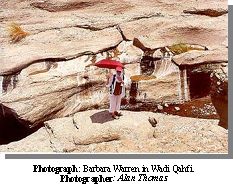 |
 |
Charles Laubach's trip to Wadi Qahfi was more than about chasing wadis and elusive creatures in the desert.
It started with us watching India versus Pakistan on the nevergreens of Musallah al Eid car park and establishing phone numbers for those oblivious to their own mobile phone numbers.
Our compact convoy of 4 vehicles headed out of town on the Sweihan Road, a road with civilized traffic. We turned left at Al Hayer onto the Al Ain - Dubai Road. At Al Khedar we took the Fujairah turnoff, passing the spectacularly empty Shwaib Dam, reportedly built after the last big floods several years ago. In the hazy distance we could just make out Jebel Rawdah and Jebel Sumaini, the high peaks that ENHG members are known to have climbed on previous trips.
After rounding the Al Madam roundabout we headed to Hatta in the jagged Hajar Mountains. Here, too, we saw curious signs that indicated that this land is not always without water.
"Vehicles passing during high tide not allowed"and
"No swimming."
When you see these signs you can be assured that you are, in fact, heading to Wadi Qahfi -- not Hatta New Towns. This wadi is about 12 km from Hatta and visible from the track. An active falaj runs parallel to it at this point.
Charles fearlessly led us, by foot, southwards from this point through blistering sunshine and dehydrating winds into cool wadi waters. There were clean deep pools and plenty of shade to keep us comfortable. Some of us swam, slid and chimneyed along narrowed sculptured canyons before emerging on top of a rusted-out car body into blinding sunlight.
Chirri, our 4 footed companion, abandoned her red, insulated designer shoes to accompany us. Roy, on the other hand, donned his diving boots and kept more upright and more attached to the rocks than the rest of us -- diving boots are therefore highly recommended when contemplating this wadi.
The wadi appeared to provide home to 3 types of fish, the Arabian toad, a water scorpion and dragonflies. Having "done" the southern pools we slowly plodded behind Charles to the northern pools fed by the same source as the falaj.
Charles suddenly leaped down 10 feet or so into a pool and seemed disappointed that the following under 6 footers did not join him.
Roy and Chirri guarded Charles' departure point whilst the rest of us fled to the spindly shadows of Samar trees. It seemed an eternity before Charles returned, having been rescued by passing tourists - his height and mountaineering skills not quite up to the challenge of Wadi Qahfi.
Sadly at this point 2 party members decided that they had enough of the 48.7 degree heat and headed home.
We then took refuge in air-conditioned 4WDs and headed south to Al Sabakh oasis with promise of lunch under date palms. However, a gate and fence had been erected since last visits and we had to do with the "shade" of another Samar tree.
Again time for an a-c break. We drove towards Nuway, taking a brief stop at Al Shuwayah oasis and wadi wall. Although there were no pools, we did sight 3 desert larks, palm doves, yellow vented bulbuls and a purple sunbird.
At Nuway oasis we explored the deserted fort and village -- dusty buildings surrounded by hundreds of rusty tins and ammunition boxes. The oasis is large with lemon trees, european fig, date palms and bleating sheep. Bangladeshi workmen greeted us warmly and told us not to "fear"!
The falaj was active and here too had fish swimming upstream.
The final journey out of the Hajar al Gharbi was through grey dust into orange/red sand dunes which increasingly covered the mountains the further SW we went.
We emerged unscathed onto the Al Ain-Dubai road just south of Al Hayer where we gathered for a group photo at sundown. The temperature had dropped to 42.5 degrees!
From there it was a pleasant cruise back to Abu Dhabi along the civilized Sweihan road, after what was a most enjoyable day.
Many thanks to Charles for showing us some of the Emirates' secrets, and to Roy for his hospitality and safe driving.
Liz Carpenter and Barbara WarrenReturn to top of page.
Ras Al Khaimah High Road (or "7 Emirates in 7 hours") Friday, 19th July 2002
The intrepid explorers (headed by Charles with Liz, Martin, May, Keith, Liz and Barbara bringing up the rear) headed for Ras Al Khaimah via the Emirates Road (311). The highlight of the motorway journey, on the wildlife side, was spotting two Egyptian geese and some "fluffy" goats. We managed to lose one vehicle on the way to the Sharjah/Ajman road leading to Ras Al Khaimah, but as we had planned to stop for some refreshment at the Bin Majed Beach Hotel, there was time for them to catch us up. Since the hotel gave us our only chance of decadence on this trip, we treated ourselves to cake and éclairs -- delicious!
Back on the road, the scenery became more interesting as we passed the Al Qawasim Corniche and a long stretch of trees on both sides of the road. Soon, we had Wadi Al Beah in our sights. At this point, we came upon a lone 4 wheel drive flashing its warning lights so we pulled over to see if we could help (perhaps they were lost or the vehicle had a mechanical fault?). However our heroics were not required as the "emergency" was the driver on a "hot" line to his bank, making some vital financial transaction!
Continuing our journey, with Wadi Al Beah on our left and Wadi Qudaa on our right, we were ready for the "long and winding road" leading us up through the mountains. But not before long we came under the scrutiny of an armed guard at a road barrier. (Was this "boy" old enough to carry a machine gun? I asked myself). He dutifully took down car registrations and checked driving licenses before we were allowed on our way. Having "clocked" the highest temperature of the day at 50° C, we were counting on a more "travel friendly" atmosphere later on. It was a steady incline at first, with Wadi Al Beah constantly in our sights, we strained our eyes and were rewarded with the sight of a very small pool.

Onwards and upwards we forged on, the jagged rocks on either side forming a dramatic site. Stopping to capture the scenery on film, we were able to witness just how steep the climb had been (although the ringing in my ears was a clear sign to me!) The prospect of lunch spurred us on to the uppermost road where we found the best picnic site had already been snatched from us by another group of rather "poshly" dressed explorers (how dare they!) Still, undaunted, we chose an equally shady spot, surrounded by almond, fig, date, zyzyphus and acacia trees and soon we were tucking into our vittles with gusto. We were so engrossed in our food, we did not notice a "posse" of goats (or should that be "herd"?) quietly surrounding us, hoping for a tit bit. No chance! However, then the "heavies" arrived -- giant sized goats with rather menacing horns moved dangerously close, bringing a halt to our enthusiastic munching! Luckily, our patience and bravery paid off and the "enemy" retreated. (Whew!)
Having satisfied our hunger, we set off to explore our surroundings, at a steady pace. Taking a circular route, we found what was once a dwelling house, intact, apart from a door. Close by, we discovered some bones, obviously the remains of an animal (we hoped!). Climbing to higher ground we explored a burial ground which was easily visible as each grave was above ground bearing a large stone marking each end. One of our party had heard that a female grave was marked with an extra stone positioned in the centre but there were no such signs on this site.
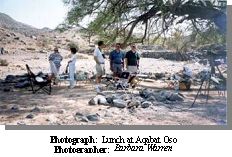 |
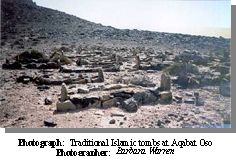 |
A welcome breeze brought a slightly cooling effect (the coolest temperature was registered here at 32° C) as we ventured higher to enjoy the dramatic views around us. An interesting mound of stone off to the right prompted most of the party to investigate further while I made a slow descent, checking out further remains of life (and death!) There was certainly evidence of local dwellings, happy campers (remains of neat camp fires) and lager louts (empty Heinekin cans!)
When all the group was assembled together again, we de-camped and headed for our vehicles to prepare for the next leg of our journey. While we were busy "packing our trunks," a cute donkey appeared in our midst. He had chosen the perfect time to approach us since our stomachs were full, we were more inclined to part with our leftovers! (Besides, who could resist those doe eyes!) We willingly rummaged in our lunch boxes and produced tomatoes, french bread and cake, all of which were gratefully received. After much "oohing and aahing," we finally bid the donkey farewell and piled into our vehicles. As well as the four legged variety, we had also seen palm doves, desert larks and graceful warblers.
We followed the road down the other side of the mountain which would take us to Dibba. This side to be greener as we spotted many bushes and, in particular, moringa trees (which Charles was so intent on finding, he almost drove off the road looking for them!) We noticed signs of life on the downward journey, following a line of electricity pylons upwards leading to more dwellings high up on the mountainside.
Finally reaching the bottom, we drove past Dibba Port and headed towards the beach to inspect another burial ground which was apparently the scene of a battle between an Islamic army and the indigenous people 1400 years ago when 10,000 lives were lost. Each grave was marked by one solitary stone buried in the ground which gave a rather eerie feel to the area. However, looking away from the "cemetery" was a lovely view of the sea where a dhow was slowly making its way to the port.
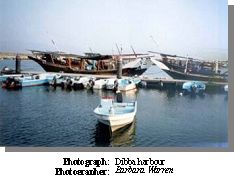
After collecting a ton (well that's how they felt in my pocket!) of shells, stones and bits of pottery, we returned to our vehicles, only to discover a flat tyre. The men set to work and before long, everything was ship shape and we were on our way.
We decided to take a look at the port and I was so pleased that we did as it was a hive of activity. The evidence of a good day's fishing lay on the quay -- huge mounds of fish with gaping mouths (not a pretty sight!) People were busy with the catch, children cycling, playing football or running around excitedly. It made a very colourful picture.
After soaking up the scene, we set forth on our homeward journey, passing pick-up trucks groaning with its load of dates, roadside shops selling a few fruits and vegetables, hoping for some passing trade.
At the next village, we encountered the Friday market, where anything from household goods to blow up Teletubbies were for sale! Then we made our steady progress via Masafi and Dhaid till we reached the Emirates Road which led us back to base.
It's hard to believe that all the aforementioned happened in just one day but, what a wonderful day it was! Many thanks to Charles for his bottomless pit of information on such subjects as nature, geography, archaeology, history, Arabic, ornithology etc., etc.! You turned the prospect of a "boring Summer" into something really enjoyable!
Barbara WarrenReturn to top of page.
Jebel Rawdah (25th July, 2002)
Five SUV's made their way up the trail to Jebel Rawdah. The leader in an experienced vehicle slipped neatly between thorn bushes. The followers were in late model vehicles, one so late that he was still restricted to 100 kph. These glossy followers treated the thorns with much greater circumspection than the leader, and as we drew to a halt at the camp site, drivers could be seen surreptitiously inspecting their precious paint work.
It was hot, damn hot. The scribe had an irritating habit of calling out the temperature every few minutes and he started at forty seven Celsius. The measurements were the product of his favourite toy, a miniature weather station. If asked he would cheerfully call out temperature, barometric pressure, altitude, and even wind speed, in metric or imperial measure.
The wind was gusting quite strongly at times. We didn't need the weather station to tell us that because it was in the process of destroying the leader's framed canopy, the only source of shade in this hell hot Hajar valley. Yes it was tethered, braced, splinted and taped, (Roy was particularly good at this) but once the sun lost its power it was finally abandoned; its last hurrah.
The desert rocks were so hot that the dog Chirri, wore booties on each paw so that he could move comfortably. The downside for him seemed to be that it was difficult to get a good scratch while wearing booties. In extreme environments you have to make compromises.
It was an ENHG event, so we felt obliged to keep a record of wildlife. Our site was strikingly devoid of denizens; indeed we recorded but a single crested lark. As the sun dropped behind the hill and the scribe was able to call out temperatures close to forty, thoughts turned to supper. Out came a range of BBQ devices, mostly following the bic principle of disposability. By the time we ate it was quite dark, so the burnt offerings were consumed in anonymity.
Two vehicle loads were newcomers to the UAE, and it was clear that they found the temperatures even more daunting than the rest of us. They were soon on their way to the nearby fleshpots of Hatta, the city of the plain, promising to return early the next morning.
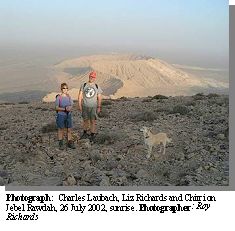 |
 |
The rest of us settled down for the night, as the temperature dropped below thirty six. Conversation waned and most of us got at least some sleep.
We had arranged to get up and start a hike at four thirty, so sure enough by four fifteen whispered conversations and beams of light came from all sites. There was a full moon and we were able to climb to the ridge that led to the summit.
The scribe was unfit, and loaded with more photographic hardware than was wise, so he lagged. At six hundred m. by his altimeter function, he ran out of steam. The rest of the party set off for the summit while he, watched by his long suffering wife took a series of photographs of the Hajar Mountains in the sweet light of morning, then packed up his gear and set off back to the camp.
Jebel Rawdah, away from its ridges is a pile of loose sharp rocks. About half way down, long suffering wife was horrified to see the scribe trip, fall and roll towards a precipice. The fall was arrested short of total tragedy, and the battered scribe was able to sit on a rock to recover his senses. Looking down he saw in his lacerated leg structures that should never see the light of day. Slowly, slowly the couple descended to camp and fashioned a remarkably efficient dressing out of a clean T shirt and a supply of duct tape.
That was the end of their weekend. They drove back to Abu Dhabi, where the ER staff marvelled at the ingenious use of duct tape. Then a plastic surgeon who had nothing better to do with his weekend, spent time restoring the leg to a semblance of normal.
While our scribe was making an early descent, four of us (Steve, Roy, Liz and Charles) enjoyed the view at the top and a descent through a wadi. Although it was the middle of a dry summer in a dry climate, the wadi bed contained perhaps 12 to 15 plant species, compared to maybe 5 or 6 on the plains where we camped, which made for an interesting descent. Back at the campsite, we bid farewell to scribe, who needed stitches, and wife, who drove him, and welcomed back the two parties who had elected to overnight in the Hatta Fort Hotel. We drove together through Wadi Al Qawr, and visited the abandoned copper mining camp near Huwailat. We finished the weekend with a drive through Wadi Helu to the coast, for a picnic lunch beneath the palm trees on the Kalba Corniche, where it was more humid and even hotter than the afternoon before in the mountains.
Huw Jenkins and Charles Laubach.Return to top of page.
Twitch It! - Abu Dhabi birds for July and August
With the heat and the summer holidays, it's been fairly quiet over the last couple of months in terms of birds in and around Abu Dhabi - or, at least, in terms of those being reported. A summary of the available records follows, and thanks to Andrew Twyman for getting out and about as soon as he returned from summer leave to provide us with the bulk of the material! As his reports for August show, the 'autumn' migration is now beginning to get under way, with the first raptors, waders and passerines all appearing. To the records.
From 6th July, we have reports from Futaisi, thanks to Sheikh Hamad bin Hamdan Al Nahyan, who kindly took a few people out on his boat to inspect a dead whale. As far as the birds went, on Futaisi island and an adjacent spit of dredged material were 2 Socotra cormorants, 3 ospreys, 50+ bridled terns (which bred on the spit, but whose success affected by extensive egg-robbing), 10+ white-cheeked terns, a sanderling and a sand martin. On and around the delightfully-named "Pirate Island," a few kilometres to the north-east, were another osprey, 10+ white-cheeked terns, 5+ bridled terns, and, recent arrivals from Abu Dhabi city, a white-cheeked bulbul, a common mynah and 5+ house sparrows!
On Abu Dhabi island itself, also on 6th July, a pair of Egyptian geese were at Sheikh Hamad's Bateen boatyard, the female incubating a clutch of 8 eggs. A pair of peacocks has also bred in the boatyard this year.
Into August, and on the 20th, a red-backed shrike was at Mushrif Palace Gardens and 3 common sandpipers and a wood sandpiper at the AD Health and Fitness Club.
On 21st August, 2 whimbrel were in central Abu Dhabi with a greenshank and 2 swift terns at the Western Lagoon. Another whimbrel and 3 common sandpipers were at the Health and Fitness Club.
On 22nd August, a first set of records for the autumn from the Al Wathba Camel Track included a Montagu's harrier, 1 kestrel, 17 black-winged stilts, 3 collared pratincoles, 16 Pacific golden plovers, 23 red-wattled plovers, 8 ruff, 32 turtle doves, 7 Egyptian nightjars ( after dark), 2 gull-billed terns, 2 yellow wagtails, 3 isabelline wheatears and 3 Southern grey shrike.
And that was the lot as we went to press.
Best bird in the country over the last couple of months has been the UAE's 1st red-knobbed coot, up at Wimpey Pits in Dubai, first seen in late June and still there last week, associating with a juvenile common coot. If you haven't 'ticked' it, there's probably still time to go up and get it.
Best from Abu Dhabi and the surrounding areas were the Egyptian nightjars at the Al Wathba Camel , a species much sought after by visiting birders.
More next month.
Peter Hellyer(The Twitch It! Report is compiled from the weekly Twitchers' Guide newsletter, compiled by Simon Aspinall and Peter Hellyer, which can be found on the Ministry of Information website at www.uaeinteract.com Records, please, to Hellyer@emirates.net.ae OR Hudhud10@emirates.net.ae and information:
Twitchers' Guide (Simon Aspinall & Peter Hellyer) PO.Box 45553, Abu Dhabi, UAE.Tel: (Mobile): Abu Dhabi 971-(0)-50-642-4358/642-4357. Fax: 9712-4450458.
E-mail addresses: hudhud10@emirates.net.ae OR hellyer@emirates.net.ae
Records should also be submitted to the Secretary of the Emirates Bird Records Committee, David Diskin (dadiskin@emirates.net.ae), from whom a full listing of species requiring formal descriptions can be obtained.
Please note that NO records will be included in the national record unless they have been formnally submitted to the EBRC for adjudication.
For birding information on Dubai and the Northern Emirates, please contact Colin Richardson. P.O.Box 50394, Dubai, UAE, e-mail: colinr@emirates.net.ae
Reports from Oman are courtesy of the local daily e-mail hotline The Oman Birder, and are not official in any way. Again, these reports should not be cited.
Return to top of page.
Fujairah Bird Checklist released
A new Checklist of the Birds of Fujairah and the UAE East Coast has been published.
The Checklist has been compiled by Simon Aspinall, Group Chairman, and also Chairman of the Emirates Bird Records Committee, and has been published under the auspices of the weekly Twitchers' Guide, produced by Simon and Peter Hellyer.
It contains a full list of the 321 bird species so far recorded from Fujairah and the East Coast, along with an introductory article (in both English and Arabic), and a selection of pictures of birds most likely to be seen. The Checklist has been sponsored by the Union Water and Electricity Company, UWEC, a UAE Offsets company, which is building the new power and desalination plant at Qidfa and the associated water pipeline across the mountains to Al Ain.
The checklist is the second in a series, the first, Birds of Abu Dhabi, having been produced last year. Copies will be available at Group meetings for the give-away price of Dh 10.00 apiece.
Peter HellyerReturn to top of page.
Lectures
| Date | Topic | Presenter |
| 3rd September | Reptiles of the UAE & Oman | Drew Gardner |
| 17th September | Desert Safety | Charles Laubach |
| 1st October | Cattle, soil, plants and ants! The northern Chihuahuan Desert of New Mexico, USA | Amrita de Soyza |
Return to top of page.
Committee members
Simon Aspinall(Chairman)
Mobile: 050+6424358
e-mail: hudhud10@emirates.net.ae
Richard Perry
(Deputy Chairman)
Mobile: 050+4418623
e-mail: rperry@erwda.gov.ae
Wafa Morda
(Secretary)
Ph: 6320126
e-mail: wmordaa@emirates.net.ae
Hazim al Chalabi
(Membership Secretary)
Ph: 6654372
e-mail: hchalabi@adco.co.ae
Peter Hellyer
(editor of Tribulus)
Mobile: 050+6424357
e-mail: peter@extinfo.gov.ae
Charles Laubach
(Member at large)
Ph: 6275134
e-mail: aaadh@emirates.net.ae
Arleen Edwards
(Sales)
Ph: 4454992
e-mail: edwards@emirates.net.ae
Andrew Twyman
(Sales)
Ph: 6668462
e-mail: atwyman@emirates.net.ae
Arun Kumar
(Treasurer)
Mobile: 050+6150328
e-mail: hampi@emirates.net.ae
Dick Hornby
(Member at large)
Ph: 6274049
e-mail: dnahornby@yahoo.co.uk
Ingrid Barcelo
Mobile: 050+5325713
e-mail: scruff@emirates.net.ae
Allestree Fisher
Ph: 02- 6775717
e-mail: allestree.fisher@hct.ac.ae
Drew Gardner
drew.gardner@zu.ac.ae
Return to top of page.
Excursions
Preview of Qarn Nazwa, Wadi Kahl field trip September 5-6th 2002
Departure will be at 08.15 sharp from behind Popeye's. The convoy will head off towards Dubai, and turn on to the Hatta road at Jebel Ali. The first major stop will be at Qarn Nizwa for coffee and a plant survey. There is also a resident eagle owl. Lunch will be either at Jebel Rowdhah, Jebel Buhays or Jebel Emalah, depending on conditions. A second stop will be made at the "limestone" wadi area for aquatic species and flying insects. Convoy will proceed to the village of Kahl and beyond for overnight camping. Setting up camp, tea and a survey of the sand dunes come next. There may be a good view of the stars depending on conditions. We plan to depart from the campsite at about 09.30, for a nearby oasis site. There will be a tour of the gardens and walk along a falaj. We may have lunch in the oasis. Return to AD will be approx. 15.30, via Buraimi, arriving in AD from 19.00.
Allestree FisherReturn to top of page.
Corporate Sponsors of the ENHG 2002
The following companies are supporting the ENHG's conservation efforts in the region. Each company has made a commitment, each has made a difference and the environment thanks them all. We hope you, as ENHG members will in turn support these companies whenever you can.
Al Fahim Group
Al Sayegh Richards Butler
Emirates Holdings
GAMCO
Hyder Consulting Middle East Limited
Jashanmal National Company
Mohammed Bin Masaood & Sons
Nama Development Enterprises
National Bank of Abu Dhabi
Ready Mix Abu Dhabi Limited
Simmons & Simmons
Tabreed
Trowers & Hamlins
Union National Bank
WESCO
Return to top of page.
Survey of Information for the Marine & Coastal Area Stakeholders Of Abu Dhabi Emirate.
Survey prepared by Mr. Loughland, Ph.D. student at the Center for Coastal
Management, Southern Cross University, Australia.
Abu Dhabi Contact Details: PO Box 32095, Tel: 02 5584440, 050-4917826.
Fax:02 5582224, 02 6722607 (AH) ronuae@emirates.net.ae
Thank you for taking the time to complete this survey. The aim of this survey is to identify the marine & coastal area users, and to determine the issues affecting these areas. Your information will be analysed statistically with other information and used to assist Abu Dhabi with the protection and sustainable management of its marine & coastal resources. The information provided by you will be kept private & confidential, and will not be used for any other purpose.
Q1: What is your Organisation's Name
Q2: What is your Department / Sections Name
Q3: What is your Organisations role / responsibility within the marine & coastal areas
Q4: What is your Departments role / responsibility in these areas
Q5: What is your personal role in your Department
Q6: What are the activities that your Organisation is involved in within the marine & coastal areas
Q7: What are the specific activities that your Department is involved in within these areas
Q8: What are the actual activities that you are personally involved in within these areas
Q9: What do you see as being the main problems facing Abu Dhabi's marine
& coastal areas List the problems from the most important to the least
important i.e. 1 being the biggest problem:
Q10: From your above list of problems, please indicate when you think the
problem will become critical and will start to affect your operations in the
marine & coastal areas of Abu Dhabi. i.e. Short-term (immediate),
Medium-term (over the next few years), or Long-term (within your or your
children's lifetime). Please mark Short-term, Medium-term or Long-term next to
each number below, which represents each problem from Q9 above. E.g. if the
number 1 problem you wrote in Q9 is a short-term problem, than write short-term
next to number 1 below.
Q11: Is your Organisation, Department or personal activities contributing (even if it is unintentional or accidental) to the problems you mentioned in Q9. If yes, please write what problems.
Q12: Does your Organisation, Department or personal responsibilities / activities deal with the problems you mentioned in Q9, and if yes, in which way.
Q13: What are the names of other organisations and /or the decision-makers
that are responsible for dealing with the problems you mentioned in Q9. Please
write the name of the organisation and/or the decision-maker next to each number
that corresponds to each problem from Q9 above. E.g. if the number 1 problem you
wrote in Q9 is the responsibility of a particular organisation, than write the
name of that organisation next to number 1 below.
Q14: What do you think is the best way of protecting Abu Dhabi's marine & coastal areas
Q15: This question is optional: What is your name & contact details
Thank you
Return to top of page.